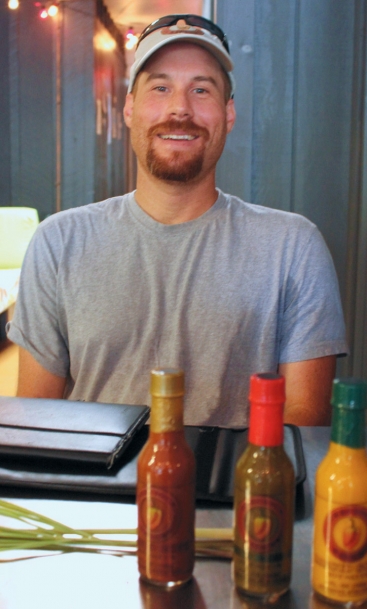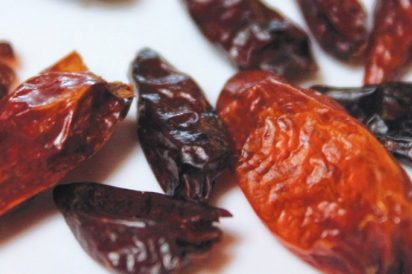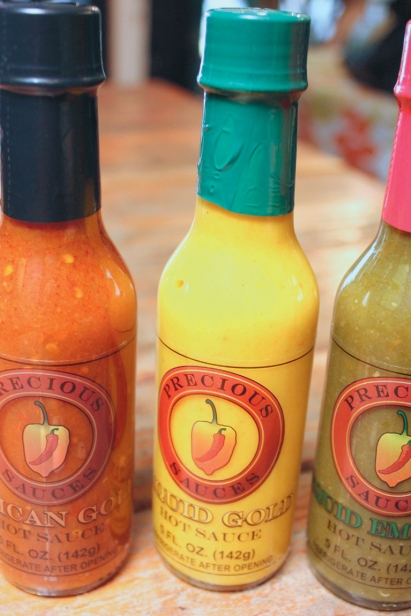Precious Sauces
A COOL TAKE ON HOT SAUCE
Stuart Hutchinson, owner and sole employee of Mesa-based Precious Sauces, says a startling thing for a man who makes hot sauce for a living: “I am not a chile head.” What he means is that he doesn’t get a rush from heat. Instead, he’s developed a line of uncommonly delicious hot sauces that treat spice not as the focal point of the picture, but as one part among many.
Hutchinson started developing his first professional hot sauce back in 2007. “I always had a passion for spice,” he recalls. That passion came under heavy fire when, during college, he developed an acid reflux issue (which acidic foods like hot sauce exacerbate). “I couldn’t cook with hot sauces because they’re vinegar-based, for the most part. It became a passion of mine to develop a hot sauce I could eat.”
His first sauce, Liquid Gold, took five years to nail. The sauce is habanero-based and employs shallots, onions and carrots to mellow the peppers’ molten heat. As Hutchinson moved from batch to batch, the sauce got better and better. He added lemongrass (which he grows in his backyard) and kept adjusting to identify just the right amount of turmeric.
Liquid Gold is a wild hot sauce. The stuff is insanely yellow and so viscous it almost has a chew, leading with tropical fruity flavors that call to mind a white-sand beach in Thailand. It’s ideal for grilled fish or cutting the umami flavor of soy- or miso-based Asian food. It packs a little scorch but has the citrusy flavor, exotic spice and island flavors to match the habanero heat.
“Habanero is the best pepper,” Hutchinson says. “It’s got the flavor, the heat, the natural smoke. Liquid Gold is the only sauce I do that has only one pepper [the other sauces have three each], because the habanero stands on its own.”
Hutchinson deftly tames the habanero heat. In an age when many hot sauce artisans seem to be in an arms race to make incendiary use of Moruga Scorpions and Carolina Reapers, peppers that torch the taste buds at a rate hundreds of times hotter than your average jalapeño, the restrained approach Hutchinson takes is refreshing. That approach is all about balancing and maximizing flavor using the least-artificial means possible. Hutchinson uses goji berries for sweetness, elderberry syrup as dye and spirulina powder (algae) as a color stabilizer.
That Hutchinson, who went to Arizona Culinary Institute, uses carrot to simultaneously thicken Liquid Gold and provide sweet earthy flavors that curb its heat—and that this is just one instance of his multi-layered and creative use of ingredients— speaks to a skilled hot sauce maker.
Better yet, starting with lime juice instead of the distilled vinegar that is used in most other hot sauces produces results Hutchinson can consume without inciting acid reflux issues. This approach changes the whole composition of his sauces. Because he uses lime as a means of achieving mild acidity (as well as a small addition of softer vinegars, such as rice and cider), Hutchinson cannot safely ferment his peppers—so he doesn’t. (Many hot sauces, such as sriracha-style and Louisiana-style favorites, are fermented.) Furthermore, the lime juice brings tropical undertones that seem born for hot peppers.
Hutchinson bottles three other sauces in addition to Liquid Gold—his first and bestseller— moving at a rate of about 2,000 bottles a year. His two milder sauces are good. Ruby took eight batches to perfect and tracks sriracha in its heat (mildish) and sweetness (spiked via pomegranate molasses and goji berries). His Emerald (somewhat hotter) pulls deep citrusy flavor from both lime juice and makrut lime leaves.
His other, hotter sauce, African Gold, is on another tier. It’s a wicked tongue-needling sauce spotlighting the Bird’s Eye Chile from Africa.
“They’re grown in South Africa and India,” Hutchinson quickly explains. “You can’t grow the chile outside of South Africa and get the same product. The whole flavor profile will change.” The pepper, he says, could potentially thrive in Arizona given the desert heat. The obstacle to growing it here, however, is that the pepper’s growing season includes July—when the monsoons storm.
African Gold doesn’t dazzle with citrus and tropical flavors. These non-pepper flavors lurk on the edges of a nice heat that coats your mouth. Hutchinson blends the African Bird’s Eye with Thai chiles and red Fresno chiles for “a combination that gives you heat from the very front of the tongue all the way to the back of the throat.”
Chile head or no, Precious Sauces make a solid addition to your hot sauce lineup for their uniqueness and balance.
Taking Home the Sauce
Order Precious Sauces via Hutchinson’s website (precioussauces.com). They are also available at Sible’s West gift shop in Chandler and at various farmers’ markets in and outside of the Valley. Follow the company at facebook.com/precioussauces for more information.






